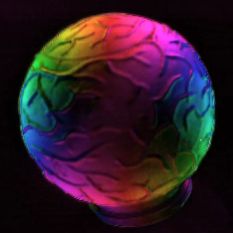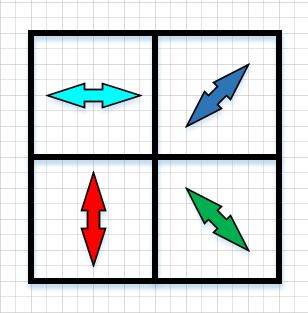See invisible. Polarization in the far infrared (8-12mkm)
 Polarization is used in many areas, the most well-known application of which is the separation of a stereo pair in 3D films in some televisions and in cinemas, this is circular polarization. When photographing, polarization filters are used to get rid of the parasitic glare due to the effect when the light becomes polarized upon reflection. But there is almost no information about the polarization with which the photons radiate and the objects around us. On the Internet, you practically will not find information and examples of how the true proper polarized radiation of objects looks.
Polarization is used in many areas, the most well-known application of which is the separation of a stereo pair in 3D films in some televisions and in cinemas, this is circular polarization. When photographing, polarization filters are used to get rid of the parasitic glare due to the effect when the light becomes polarized upon reflection. But there is almost no information about the polarization with which the photons radiate and the objects around us. On the Internet, you practically will not find information and examples of how the true proper polarized radiation of objects looks.It all started with the fact that we developed a very sensitive thermal imaging module VLM640, which had a sensitivity of no worse than 20mK in the range of 8-12µm, which is very good for uncooled bolometric cameras. The sensor manufacturer approached us and proposed an engineering sample from an experimental plate of bolometric detectors with integrated polarization filters. For us it was very honorable, but at the same time there was no understanding that we should receive as a result. The technology and the very idea of seeing our own polarization of thermal quantum photons of objects that surround us are completely new, and we didn’t have experience in processing such information.
In this article we will try to show you the polarization in the thermal imaging range, and this is still the first and only article on this topic in runet (at least we haven’t been able to find anything similar yet).
So let's get started ...
At our disposal was the electronics of the previously developed thermal imager VLM640, which made it possible to ensure the sensitivity of the bolometric sensor better than 20 mK, and the polarization sensor transmitted by the manufacturer. The uniqueness of the latter is that in a group of four pixels a polarizer is applied to each pixel (how is it applied? Do not even try to ask us, it was not possible to extort from the manufacturer). The polarization of each filter differs by 45 degrees. Total we have the angles of polarization: 0-180, 45-225, 90-270, 135-315 degrees.
')

Processing the array of data from the sensor is not a fully trivial task. If we initially solved it “in the forehead”, then the latest version of processing is more similar to the de-neurization algorithm, when more than four neighboring pixels are involved in processing each pixel. But, unfortunately, it should be noted that if the resulting image has a resolution of 640x512 elements in brightness (temperature), then in the corners of polarization it is still twice as bad.
The resulting video contains three images (from left to right): video from a conventional thermal imager, reconstructed polarization angles, an integrated image, where brightness is thermal radiation, and color is the angle of polarization.
Actually, the result is better to see once than read a hundred times, so we specially recorded articles for the article.
Light bulb
A glass light bulb is a great object to demonstrate your own polarization. Glass is opaque in the range of 8–12 µm and perfectly radiates heat, which turns out to be polarized according to the angle with which it radiates.
Ceiling light
Video with a plastic canopy demonstrates how polarization allows you to display the surface structure of an object. If there were defects on the surface of a smooth object, they could be detected due to a polarization defect.
Painted metal container
Planar objects emit quite simply, but each face is at a different angle of polarization. In the visible or thermal imaging range, one frame could not be said about the angle of the face. Taking into account the polarization of radiation, this becomes possible.
Metal plate
A clean metal plate is a complex object, it does not want to radiate, but tries to reflect heat from other objects. The square is marked on the center with a marker; this part (plastic) radiates a little better.
Ice in a glass
It looks quite interesting ice. In general, polarization emphasizes surface defects, even minor ones. There is a suspicion that polarization might help in recognizing cracks in the ice. But it is still only autumn, it is not so cold, there is no ice, and we are not able to test the assumption in practice =)
And a separate frame of the real image from the street.

UAZ
A small Habr-paragraph in the form thanks to our programmer.
Initially, we recorded the video and processed in the lab. Such a mathematical "rendering" required a lot of time and did not allow to evaluate the video in real time. An attempt to transfer real-time processing to a PC allowed us to get a display frequency of 4 frames per second, and when post-filter was added to processing, the frame rate dropped to one per second. The only way out is to transfer processing in directx to shaders; one cannot say that everything went smoothly, but it still seems surprising to us that even the integrated video card receives and processes 50 frames per second. Ilya - zhelezyachnik you respect =)
ps: if someone from the respected habr-community will tell you whether it is possible (and how) to take back the video from the shader to save to avi - would be very grateful. "
ps: if someone from the respected habr-community will tell you whether it is possible (and how) to take back the video from the shader to save to avi - would be very grateful. "
Results and conclusions:
We were able to show the brightest moments of using the registration of radiation of objects in the range of 8-12 microns. But, since we are the developers of radio-electronic equipment, and not doctors of science in the field of photometry or optics, it is difficult for us to evaluate the possibilities of using this physical property and device.
For now, we can say that polarization allows us to tell about the surface of an object.
There are suggestions (based on the results of communication with the manufacturer of detectors, colleagues at exhibitions and very scarce information on the Internet) that the effect of evaluating the polarization of emitting and reflecting objects can be used in the following areas:
- Difference of its own radiation from reflection (for example, a warm car from the glare of the sun in a puddle or from sand / stone)
- Search for masked objects
- Search for oil stains on the surface of the water
- Defect Search
- Removal of 3D object geometry
- Detection of a warm object (sinking person) on the surface of the water, separating the sun glare from the object's own radiation.
Is it possible to increase the sensitivity? Yes, it is possible, but for this you need to stabilize the temperature of the chamber (narrow its working temperature) and carry out additional calibrations, we have not done this yet, but there is such potential.
Perhaps, after reading the article, you will have an idea that it would be interesting to photograph - write in the comments, discuss and try to implement.
We hope that this article was interesting, and we managed to tell and show something new that we had never encountered before. I would like to thank Alexey, who developed the image processing mathematical apparatus and prepared the video, Ilya, who transferred almost all the processing to the shaders, to the NPK Photonics team for the opportunity to work with a unique detector, yet “Seeing the invisible” is at least interesting and exciting.
Source: https://habr.com/ru/post/422535/
All Articles